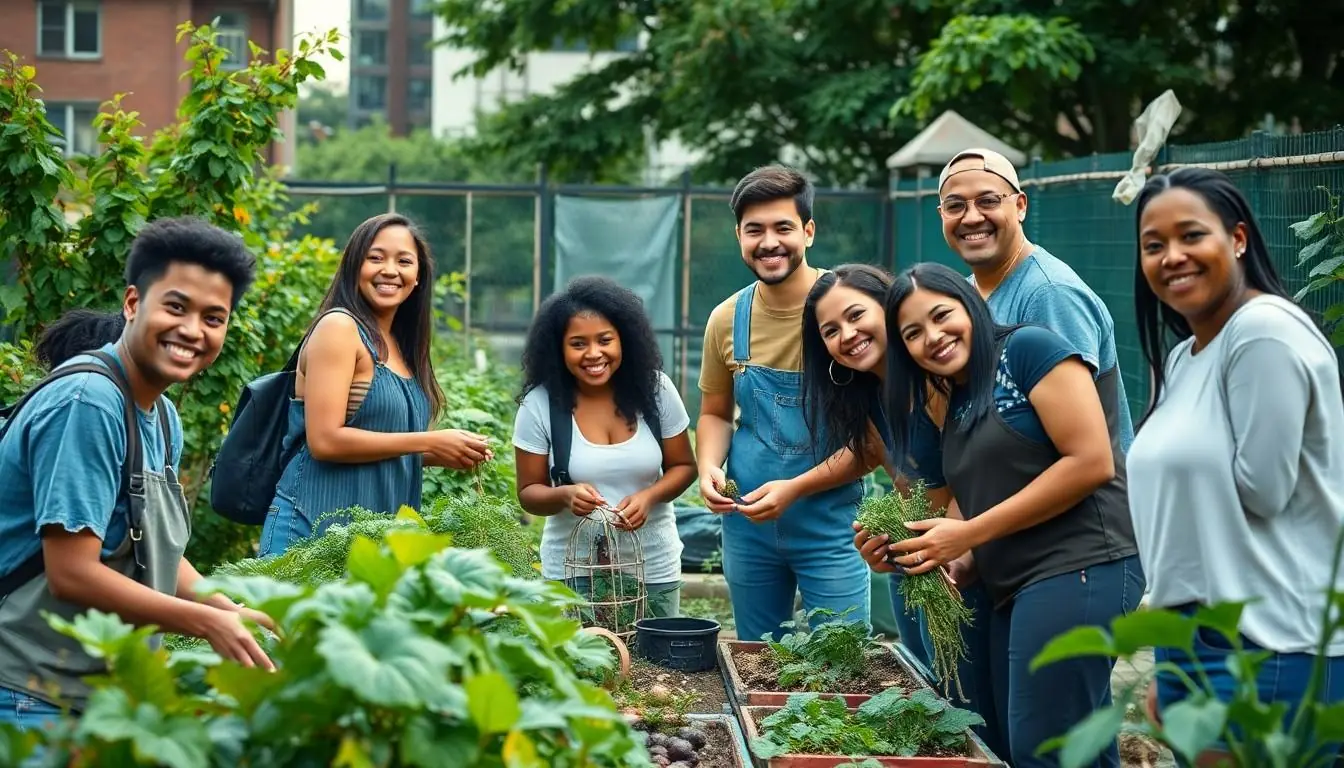In a world where plastic seems to outnumber people and climate change feels like that uninvited guest who just won’t leave, sustainable living solutions are more crucial than ever. Imagine a lifestyle where you can reduce your carbon footprint while still enjoying your morning coffee and the occasional Netflix binge. It’s not just a dream; it’s a reality waiting to be embraced.
Sustainable living isn’t about giving up everything you love; it’s about making smarter choices that make the planet smile. From quirky DIY projects to energy-efficient gadgets, there’s a treasure trove of options that can transform everyday life into an eco-friendly adventure. So buckle up and get ready to explore how small changes can lead to a big impact—because who said saving the planet couldn’t be fun?
Table of Contents
ToggleOverview of Sustainable Living Solutions
Sustainable living solutions focus on reducing one’s environmental impact while enhancing quality of life. Many options exist that allow individuals to make eco-conscious choices without significant sacrifices. Energy-efficient appliances lead to lower utility bills and decreased energy consumption.
Renewable energy sources such as solar panels offer substantial benefits, allowing homes to harness clean energy while bolstering self-sufficiency. Individuals can invest in water-saving fixtures to reduce water waste and conserve valuable resources. Urban gardens contribute by providing fresh produce, which lowers carbon emissions associated with transportation.
Using reusable products, like stainless steel water bottles or cloth shopping bags, replaces single-use plastics effectively. Composting organic waste reduces landfill contributions and creates nutrient-rich soil for gardens. Individuals can explore public transportation, cycling, or walking for daily commutes, which decreases fossil fuel reliance.
Local sourcing of food and products supports nearby economies and minimizes transportation emissions. Plant-based diets offer significant environmental benefits through reduced resource consumption and lower greenhouse gas emissions. Each small change contributes to a collective impact when adopted by many.
Engaging in DIY projects can provide personalized solutions that enhance sustainability at home. Individuals can choose to upcycle old furniture or create energy-efficient home improvements. By prioritizing these sustainable living solutions, they can enjoy a fulfilling lifestyle that respects the planet. Each action reinforces a commitment to sustainable practices, paving the way for a healthier future.
Benefits of Sustainable Living

Sustainable living offers numerous advantages that promote a healthier planet and improve individual wellbeing. Implementing eco-friendly practices contributes significantly to both environmental health and personal finances.
Environmental Impact
Reducing carbon footprints proves essential for combating climate change. Using energy-efficient appliances lowers electricity consumption, cutting down greenhouse gas emissions. Urban gardening provides fresh produce while decreasing transportation emissions. Adopting alternatives to single-use plastics minimizes waste, directly addressing pollution. Composting organic waste enriches soil and reduces landfill contributions. Collectively, these actions foster a more sustainable ecosystem, leading to improved biodiversity and healthier air quality.
Economic Advantages
Sustainable living practices create long-term financial savings. Investing in renewable energy sources can significantly reduce monthly energy bills. Individuals who choose local food options support local economies while benefiting from fresher produce. Energy-efficient fixtures lead to lower utility costs, offering significant savings over time. Prioritizing public transportation, cycling, or walking reduces fuel expenses while contributing to better community health. Overall, these decisions promote economic resilience by encouraging sustainable practices that benefit individuals and local markets alike.
Practical Sustainable Living Solutions
Sustainable living incorporates practical strategies that make a significant impact. Two primary areas to focus on include energy efficiency in the home and effective waste reduction.
Home Energy Efficiency
Enhancing energy efficiency in residences lowers energy consumption. Individuals can replace traditional bulbs with LED lights to use less electricity. Energy-efficient appliances significantly decrease overall energy usage, yielding savings on utility bills. Installing programmable thermostats allows better temperature control, optimizing heating and cooling systems. Utilizing proper insulation improves the home’s energy retention, ensuring a comfortable living environment. Solar panels offer a renewable energy source, reducing dependence on fossil fuels. According to the U.S. Department of Energy, households can save over $500 annually by upgrading to energy-efficient products.
Waste Reduction Strategies
Implementing waste reduction strategies helps minimize environmental impact. Using reusable bags, bottles, and containers decreases single-use plastic waste. Composting organic materials enriches soil while diverting food scraps from landfills. Repairing broken items rather than discarding them prolongs their lifespan, reducing overall waste. Participating in buy-back or exchange programs promotes recycling and allows individuals to acquire goods sustainably. Adopting a minimalist lifestyle encourages mindful consumption, focusing on quality over quantity. The Environmental Protection Agency states that reducing waste by just 10% can save approximately 1.5 million tons of material from landfills annually.
Community-Based Sustainable Initiatives
Community-based initiatives play a crucial role in advancing sustainable living. These programs focus on strengthening local networks and resources for a more sustainable future.
Local Food Systems
Local food systems encourage sourcing produce from nearby farms and markets. By reducing transportation impacts, these systems cut down on greenhouse gas emissions. They also emphasize the importance of supporting local economies, which stabilizes food prices. Communities that engage in farm-to-table practices promote healthier eating habits through fresh, seasonal produce. Community gardens represent another viable option, enabling individuals to grow their own food while fostering social connections. Emphasizing local food systems contributes to food security and environmental sustainability.
Renewable Energy Projects
Renewable energy projects capture the essence of sustainable community living. Initiatives such as community solar farms allow residents to share in clean energy production and lower electricity costs. Their widespread adoption not only reduces reliance on fossil fuels but also encourages energy independence. Partnerships with local governments can facilitate the development of wind and solar energy resources, providing job opportunities in the process. These projects also demonstrate the collective power of communities in tackling climate change. Milestones in renewable energy project implementation position neighborhoods as leaders in sustainable practices.
Challenges in Implementing Sustainable Living Solutions
Implementing sustainable living solutions faces several obstacles. Economic concerns arise when individuals hesitate to invest in energy-efficient appliances or renewable energy sources due to initial costs. Many also struggle with a lack of access to eco-friendly products or resources, especially in urban areas where options may be limited.
Education plays a key role in this scenario. Without adequate understanding of sustainable practices and their long-term benefits, individuals may not prioritize changes in their lifestyles. This gap in knowledge can hinder community engagement and participation in local sustainability initiatives.
Additionally, habit formation complicates the transition to an eco-friendly lifestyle. People find it challenging to break free from long-standing habits, like relying on single-use plastics or conventional transportation methods. This resistance often stems from comfort and familiarity, which can be difficult to overcome.
Infrastructure issues contribute significantly to the challenge. Limited public transportation options in some regions discourage individuals from opting for eco-friendly travel. Inadequate facilities for composting or recycling also diminish the feasibility of these practices.
Furthermore, societal norms and peer pressure may perpetuate unsustainable behaviors. When sustainability is not a shared priority in a community, individuals may feel isolated in their efforts, leading to decreased motivation.
Addressing these challenges requires a multifaceted approach. Collaborative efforts at the community level can enhance resource sharing and knowledge dissemination. Empowering individuals through education and access to affordable sustainable solutions can facilitate meaningful behavioral changes.
Embracing sustainable living solutions is essential for fostering a healthier planet and enhancing individual well-being. By making informed choices and engaging in community initiatives, everyone can contribute to a more sustainable future.
The path to sustainability is paved with small, impactful decisions that collectively create significant change. From opting for energy-efficient appliances to participating in local food systems, each action matters.
While challenges exist, the commitment to eco-friendly practices can inspire others and strengthen community ties. By prioritizing sustainability, individuals not only improve their quality of life but also play a vital role in combating climate change for generations to come.



